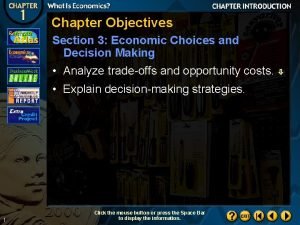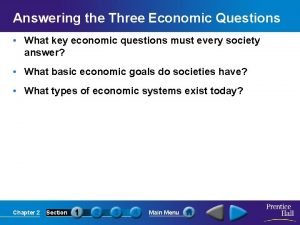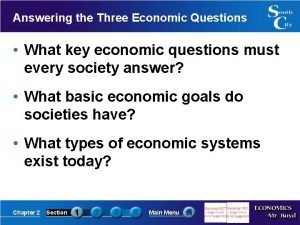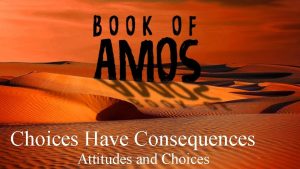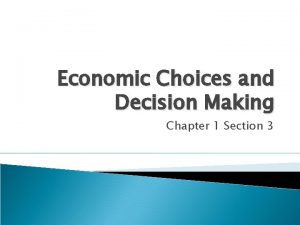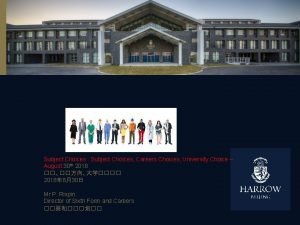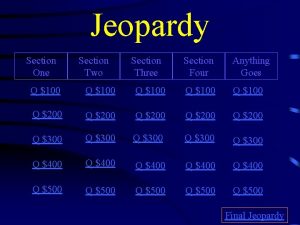Chapter One Section Three Economic Choices and Decision








- Slides: 8

Chapter One – Section Three Economic Choices and Decision Making

I. Economic Choices and Decision Making a. Trade-Offs and Opportunity Cost 1. Trade-Offs a. These are simply alternative choices b. Identify the criteria used to evaluate the sources, and base each alternative on the criteria you selected 2. Opportunity Cost a. The cost of the next best alternative (money, time, resources) b. You must recognize the cost of the alternatives, and make a choice from among the alternatives

II. Production Possibilities 1. Economists use the Production Possibilities Frontier, which is a diagram that represents various combinations of goods and services an economy can produce when all productive resources are fully employed a. Identifying Possible Alternatives 1. Economies can produce at any point on the curve or inside 2. Any point outside is unattainable 3. Points on the curve are maximum production possibilities

b. Fully Employed Resources 1. Trade-offs will have to be made if production is already at it’s maximum. 2. If you are not at maximum production, one or the other good can be increased c. Opportunity Cost 1. To produce more guns or butter, any combination is possible, but you will have to give up some production of the other good d. The Cost of Idle Resources 1. If any resources are idle (employees, buildings, factories, land) an economy cannot produce on it’s frontier. It is not utilizing all its production capacity

e. Economic Growth 1. Population growth, capital stock may grow or productivity may increase Each of these can lead to economic growth. 2. Growth is possible be having more resources or increased productivity III. Thinking Like an Economist a. Build Simple Models 1. Reduce complex situations to their most basic elements 2. PPF and Circular Flow Model are examples 3. All models are based on assumptions 4. If a model results in a prediction that proves to be true, it can be used again

b. Employ Cost-Benefit Analysis 1. Compares the cost of an action to the benefits received 2. Most businesses choose to invest in projects with the highest return per dollar spent c. Take Small, Incremental Steps 1. If there are many unknowns take small steps to reduce cost, so your plan can be revised or reversed (think about drinking coffee)

IV. The Road Ahead 1. More than just the study of scarcity 2. Why products are made 3. How a free enterprise system (one were production is decided by consumers and privately owned businesses) works a. Topics and Issues 1. Property Rights, Competition, Supply and Demand, Price System, Economic Incentives, Unemployment, Wages, Inflation, Productivity, Economic Growth 2. All have a bearing on your standard of living

b. Economics for Citizenship 1. Most political problems have important economic aspects a. Should we balance the federal budget? b. How can we keep inflation in check? c. How can we strengthen the economy? c. Making Rational Choices 1. Study of how choices are made and what’s given up for those choices 2. Making decisions for a group of people is hard to do (where to eat? ) 3. Society is dynamic and always changing
 Chapter 1 section 3 economic choices and decision making
Chapter 1 section 3 economic choices and decision making Chapter 1 lesson 2 our economic choices worksheet answers
Chapter 1 lesson 2 our economic choices worksheet answers Objectives of decision making
Objectives of decision making Investment decision financing decision dividend decision
Investment decision financing decision dividend decision Chapter 2 section 1 answering the three economic questions
Chapter 2 section 1 answering the three economic questions Chapter 2 section 1 answering the three economic questions
Chapter 2 section 1 answering the three economic questions Chapter 2 economic systems and decision making answer key
Chapter 2 economic systems and decision making answer key Chapter 2 economic systems and decision making
Chapter 2 economic systems and decision making Chapter 2 economic systems and decision making
Chapter 2 economic systems and decision making
